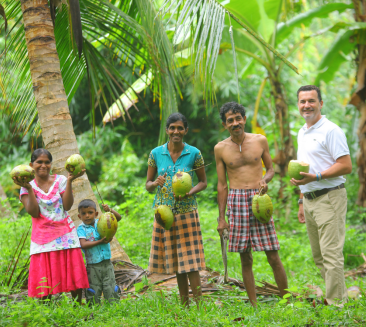the coconut juice for green coco
As you know, there is nothing else in green coco drums other than 100% coconut juice from healthy coconuts. And these are not just any coconuts. For green coco europe coconut products, we go to great lengths to ensure you can always buy the best quality – with a clear conscience …
The coconut palms grow in the tropics. More specifically, 1,000 kilometres either side of the equator. This is because in order to be happy they always like it to be consistently warm and humid. To be even more specific, the mothers of our coconuts grow in Brazil, Sri Lanka and in the Philippines. For over 22 years we have spoken to many small farmers and local cooperatives and established long-term contracts. Many even with just a handshake, because trust is our greatest asset. We know that we can trust our suppliers, and our suppliers know that they can trust green coco europe.
Together we have certified the plantations as organic and we continue to work on ensuring that more and more plantations are managed sustainably, so that we can harvest valuable coconut juice.
Furthermore we certified plantations and production facilities FLO Fairtrade to support CSR as far as possible, supplemented with SMETA 4 pillar audits.
read more ...
We would rather accept the fact that you will not always be able to find every coconut juice quality in our warehouse. Because we know that you as our customers appreciate that nature cannot simply be expanded at will.
The cultivation of organic coconut palms is very natural. They grow as nature intended. No greenhouses, no fertiliser. No GMO. All organic. Pure taste. And the raw material recovery process is also no secret. Nut open – juice out. The coconut farmers harvest the coconuts and take them to our partner businesses in the country in which they were grown. There, the nuts are opened and the fresh coconut juice is immediately filtered, gently pasteurized. As fresh juice or concentrated one.
Coconuts do not grow at our latitudes. A long transport route is therefore unavoidable. But right from the outset, green coco europe has aimed to keep the negative impact of our actions in the production and sale of coco products as low as possible.
In order to minimise CO2 emissions, we do not transport any whole coconuts, instead we extract the coconut juice in the country in which they are grown. We send it by sea on the journey to Europe in containers. This allows us to save weight and volume and make use of the excellent efficiency of large container ships. According to recent studies, the amount of CO2 generated when transporting oranges from Sicily to Central Europe by truck is similar to that produced by intercontinental container ship transport of oranges from Brazil to Central Europe; calculated relative to the number of oranges, of course.
Of course we are not yet satisfied with this. That is why in a project in 2010, we already analysed the CO2 emissions during the cultivation, transport and processing of our Dr Antonio Martins coco consumer brand and interpreted this as a carbon footprint.
If you are still not sure, put your trust green coco europe – then you can’t go wrong. We promise you with conviction.
read less …





